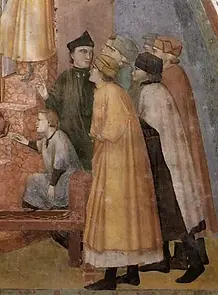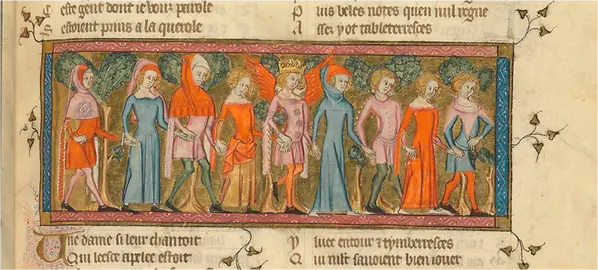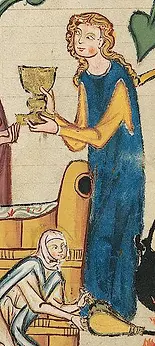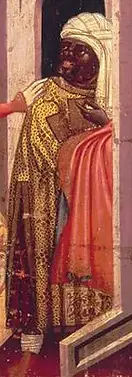
History Visits
The Colour Yellow
Here are some notes and pictures about the symbolism and manufacture of the colour yellow in Medieval times.
Dye Recipes from the Innsbruck Manuscript (c. 1330)
A Latin-German dictionary of many things - written circa 1330 C.E. in Tirol, Austria, and containing the oldest recipes for fabric dye to be found in the German language.
Swer gelbiu varb machen welle, der nem auripigmentum vnd mische si mit alaun, gesoten in ezzeich vnd verb damit.
Whosoever wishes to make yellow dye, takes orpiment and mixes it with alum, cooked in lime water (vinegar?), and dyes therewith.
Man sol peizzelpaum nemen vnd die obern rinde abschaben; dar nach sol man abschaben das grün vnd sol das sieden in alunvazzer vnd presili dar vnder mischen vnd auripigmentum vnd verb damit.
One should take barberries and peel the outer rind off; then one should peel off the green and boil it with alum-water and add brasil-wood thereto and orpiment and dye therewith.
Auripigmentum: orpiment (arsenic trisulfide). This dangerous chemical, used extensively as a pigment for painting and illumination at the time, produced a bright yellow dye.
Alaun: Alum, or Aluminium Potassium Sulfate. One of the most common mordants in the dye industry, even today. It was widely used during the middle ages to make colour fast on fabric. In modern recipes, the fabric/fiber is usually boiled in an alum-water solution, wrung out and rinsed, and then put into the dye bath. In most of the Innsbruck recipes, however, it seems that the dyestuff was combined with the alum in one solution.
Ezzeich: The translation of this word is confusing; The author at first thought it to be the MHD equivalent for the modern German word essig, or "vinegar", which was used and is used today as a mordant for fabric. In his book "Ein Buch von Alten Farben", however, Emil Ploss translates the word to mean "lime water", a water solution of carbon hydroxide. Lime Water was mentioned in Thomas Cooper's 19th century manual on dyeing as a way to bring the color out in a dye bath, to make it stronger and clearer.
Peizzelpaum: the Barberry (Berberis Vulgaris) is well known for the bright yellow dye, somewhat fugitive, which can be obtained from its berries.
Presilig: Brasilwood (Caesalpinia sappan). Although the modern name refers to the dyes found in the wood of Caesalpinia echinata, discovered in Brasil, the wood referred to in this manuscript came from Sri Lanka, India and Malasia. It produces hues ranging from pink to a deep claret, and is more fugitive than madder or cochineal. Different mordants produce a variety of different colours.
Natural Sources from Earlier
Many natural sources will produce a yellow dye - doesn't need to be as complicated as the above recipes!
Weld
Weld (Reseda luteola) gives a sound yellow colour and it's seeds have been discovered at Dyers Lane, Beverley, Humberside (AD750); York and Bristol.
Weld dye has been identified on Viking-age imported silk.
Walnut
Walnut (Juglans regia) has been identified at the Viking-age sites of Hedeby and Oseberg - the green husks produce a yellow dye. Old English - wealh-hnutu (foreign nut); Old Norse - val-hnot (Welsh nut)
Waterlogged seeds/nuts have also been identified at these sites:
-
Eastgate, Beverley, Humberside (AD750)
-
Lurk Lane, Beverley, Humberside (AD800-900)
-
Whitefriars Street, Norwich, Norfolk (AD830-1200)
-
Lloyds Bank, 6-8 Pavement, York (AD900-1100)
-
General Accident, 24-30 Tanner Road, York (AD1000-1200)
Others
-
Dyers green-weed (Genista tinctoria) gives a yellow which can be dyed over woad to give green and has been found at:
-
Coppergate, York (Anglo-Scandinavian) - flowers, leaves, stems and pods,
-
General Accident, 24-30 Tanner Road, York (AD1000-1200) - leaves and stems.
-
-
Bog Myrtle/Sweet Gale (Myrica gale) also gives a good yellow and has been found at:
-
Beverley, Humberside (AD750) - seeds,
-
Coppergate, York (Anglo-Scandinavian) - leaves and seeds.
-
-
The flowering tops of Ladies bedstraw (Galium verum) give a yellow dye.
-
Heather (Calluna vulgaris) was also very popular and has been identified in the archaeology of many sites, including West Stow (5th-7th century), Beverley, Humberside (8th c), Durham, (10th century), York (10th/11th c) Norwich (11th c).
An unidentified yellow dye was visible on Z-spun threads in both warp and weft from textile found on the front of a large cruciform brooch at the front of the body and on a wrist-clasp - interpreted as being from a cloak.
Sewerby, East Yorkshire (5th/6th century).
from my old 'Rosie and Glenn' website
“harit þat a hofði sem silki gult væri”
The hair on his head was like yellow silk
Fms. x. 381
(An Old Icelandic quote I need to trace and investigate)
Colour names
-
geolu - yellow
-
fealwe - fallow (pale yellow)
The Anglo-Saxons give use some lovely colour combination names like apple-fallow (æppel-fealu) reddish-yellow, (geolo-blác) yellow-bleach or pale yellow, (geolo-hwít) yellow-white or white with a hint of yellow, and (geolo-reád) yellow-red.
Rosalie's Medieval Woman
She states:
-
By 1200, Europe imported alum from Sicily and North Africa which was used as a mordant for fixing the colours in woolen cloth.
"It must be noted that just because it was possible for a colour to be dyed, it did not mean that it was instantly adopted by all walks of life. Many colours were deemed unsuitable for the peasant class. Bright colours, it was thought, were not humble and engendered a feeling of pride which was a mortal sin. Peasants should remember where it was that God had seen fit to place them, and they should not desire anything other than God's will."
And gives some lovely period names for colours:
-
carsey / yellow-carsey,
-
crocus,
-
isabelle (yellow or light buff),
-
jaune (bright yellow)
Jews Wearing a Yellow 'Badge'
I have collected some statements from the Wikipedia about Jews having to wear a yellow 'badge'...
-
In the last quarter of the 12th century the Almohad Yaqub al-Mansur orders that Jews must dress in Muslim fashion of mourning (dark blue or black). His successor requires Jews to wear yellow cloaks and turbans.
-
The enforcement of wearing 'the badge' is repeated by local councils, with varying degrees of fines.
-
The shape and colour of the patch/badge also varied, although the colour was usually white or yellow. The "rota" looked like a ring of white or yellow.
-
In 1274, Edward I required Jews to wear a yellow felt mark measuring 6 by 3 inches.
-
In Europe it was a yellow cone-shaped hat they had to wear.
-
Cathars who were considered "first time offenders" by the Catholic Church and the Inquisition were also forced to wear yellow badges, albeit in the form of crosses, about their person.
-
In the 14th century Emir Ismail Abu-I-Walid forces the Jews of Granada to wear the yellow badge, and Henry II of Castile does the same.
-
In 1415 a bull of the Antipope Benedict XIII orders the Jews to wear a yellow and red badge; the men on their breast, the women on their forehead.
-
In 1450 the Algerian qadi Muhammad al-Uqbani and the Flemish traveller Anselm Adornes report that Tunisian Jews are obliged to wear a distinctive piece of yellow cloth on their clothing.
Yellow: The History of a Colour by Michel Pastoureau review – a sensual celebration
This gentleman's book looks interesting - a quote from the review below:
"negative associations of yellow began to dominate from the 14th century as it became the colour of “envy, jealousy, lying, dishonour and treason”. From the late middle ages onwards, yellow was regarded as “a false, duplicitous colour that cannot be trusted”. Such ideas were reinforced by the humoral medicine of the period, according to which yellow bile was associated with a choleric temperament, one thought to be violent, unstable, rancorous and hypocritical.
Once the colour of the sun gods, yellow became the “colour of deception” and the chromatic signifier of those at the margins of society. Executioners were often portrayed dressed in yellow and in art Judas often wore a yellow robe. The yellow star of David that the Nazis forced Jews to wear from 1941 has its origins in the medieval cloth insignias Jews were sometimes made to wear. Lunatic asylums were painted yellow in central European countries and sex workers wore yellow items of clothing to draw attention to themselves in the dim light of street lamps. It is a colour that stands out:"
Yellow and Prostitutes
Here's some interesting stuff from Rosalin van der Wal who runs a blog "about my adventures in living history" called 'Silk and Iron'. I have subscribed because her stuff is very well researched!
In the Middle Ages sumptuary laws were a thing. They dictated what people should and shouldn't wear, so that it would be easy to see 'at a glance' who you were dealing with - especially in cities where a lot of folks were stuck together who didn't know each other. For example - you wouldn't want to be seen in the company of a prostitute if you were a decent hardworking house-wife - or heaven forbid - you were mistaken for a prostitute! However, the laws weren't always adhered to, or strictly policed, and differed depending on where you were. The only one stating yellow is that:
-
in 1389 in Maastricht, a prostitute had to wear a yellow piece of cloth on her veil.
The Myth of the Yellow Dress
"Where does the myth of the yellow dress come from? Vanhemelreyck (marginalen in de geschiedenis) mentions the 13th century preacher called Berthold von Regensburg, who was highly influential in the German lands. He preached that prostitutes had lost their female values. They took many souls away from god and delivered them to the devil. He was against their behaviour and fancy looks and proposed they should only wear yellow!
When we look at the laws concerning prostitutes we can safely say that the “rule” of the yellow dress for prostitutes is simply not true. It is clear though that prostitutes where not full citizens and were looked at with contempt. Mingling with them as an honourable person was something not done. Therefore medieval cities made laws to recognize them. But it was not with a yellow dress. That was an idea planted by a preacher."
A Couple More...
Strange History dot net has a few more instances of yellow items for prostitutes:
-
Leipzig: yellow cloak trimmed with blue,
-
Pisa: a yellow headband,
-
Venice: a yellow scarf,
-
Vienna: a yellow scarf.
-
in Mantua, we have a 1516 record from London where a prostitute was punished by being made to wear a yellow H (for harlot).
More Colours
The Middle English Dictionary has some quotes on colour names:
-
Yelwe (Old English)
-
from Chaucer 1390 "A beest Was lyk an hound…His colour was bitwixe yelow and reed."
-
from Bartholomews' 'Properties of Things' 1398 "Ȝolow is y-gendred of whyte drawynge somdel toward rede."
-
from a will 1368 "[His black girdle with silver buckles he bequeaths to the crucifix…and another of] yolw [with silver buckles to the image of S. Mary]."
-
from account rolls of the Abbey of Durham 1396/7 "Hangings, etc., cum nodis et capitibus leopardorum, cum circulis de blodio, cum avibus de yalow."
-
-
Jaune (Old French)
-
from wardrobe accounts of Bogo de Clare 1286 "Pro iij vlnis et dimidia de Burnet et dimidia vlna Jaune, viij s."
-
-
wode-wax / waxen - Dyers Greenweed (genista tinctoria)
Some Images

possibly from the Manesse Codex, 1304/1340 (Zurich, Switzerland)

Flemish Dancers, Romance of Alexander, 1338-44

Romance of Alexander, 1338-44 (Flanders/London)

Froissart, Poems, 1395 (France)


from the Luttrell Psalter - a musician; and the cook with helpers. (Imham, Lincs 1320/40)

Man in a yellow robe, c. 1320. Raising Of The Boy In Sessa Giotto, 1311-1320, Italy

FLANDERS or FRANCE – BnF Ms 1567 – fol. 7r – 14th century
Amour, with leg raised, leads a dance. The yellow kirtle here might actually be brown because it s the same colour as the trees.... (Roman de la Rose)

Lady in yellow surcoat, c. 1360 Hs 2505, German 1360 Speculum humanae salvationis (might be supposed to be cloth of gold oweing to the candelabra being the same colour)

Hose, helmet, cup, crown and embellishment are all the same colour? I'm not sure that hose would be made of cloth of gold, so can we assume these are yellow wool.....
c. 1360 Hs 2505, German 1360 Speculum humanae salvationis

Yellow ?cyclas, and sleeves on the men. Romance of Alexander, 1338-44 (Flanders/London)

Kirtle. c. 1300 – 1340 Cod. Pal. . Germ 848 Large Heidelberg Song Manuscript

Black man in yellow brokade, Spain, 1370 Workshop of Jamie Serra Altarpiece of the Virgin Spain (1370) Barcelona, Museo de Bellas Artes de Cataluña.

“Le Livre Des Bonnes Moeurs” – by Jacques Legrand, 1338) Nobles wearing a yellow fur trimmed surcoat and robes.
Resources:
-
'The Anglo-Saxons' by Rowena Loverance.
-
'Textiles in Archaeology' by John Peter Wild
-
'Dress in Anglo-Saxon England' by Gale R Owen-Crocker
-
Archaeo-Botanical Computer Database - http://intarch.ac.uk/journal/issue1/tomlinson/
-
‘í litklæðum’ – Coloured Clothes in Medieval Scandinavian Literature and Archaeology. Thor Ewing.
-
Plants for a Future database - http://www.pfaf.org/database/search_name.php?ALLNAMES=lycopus
-
Middle English Dictionary